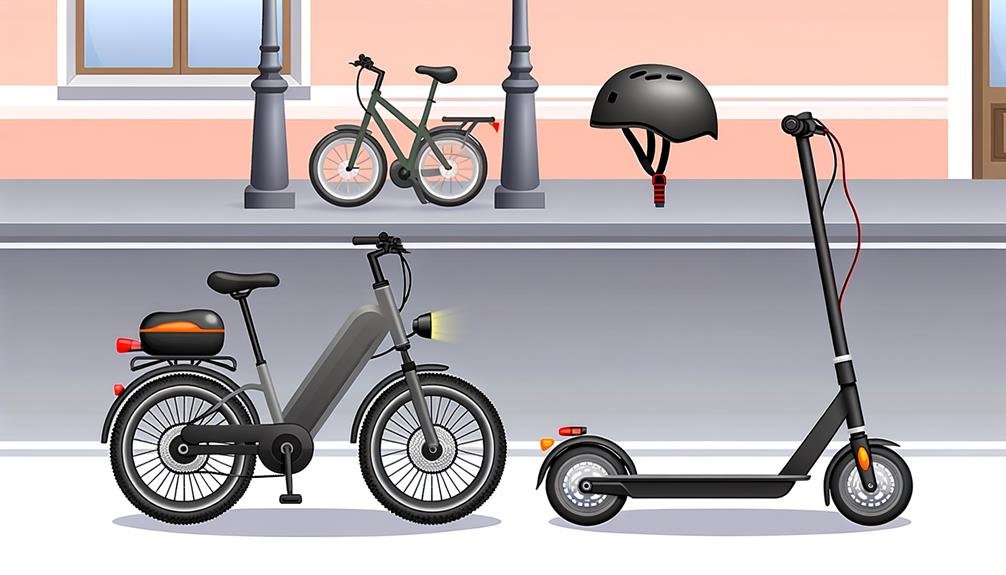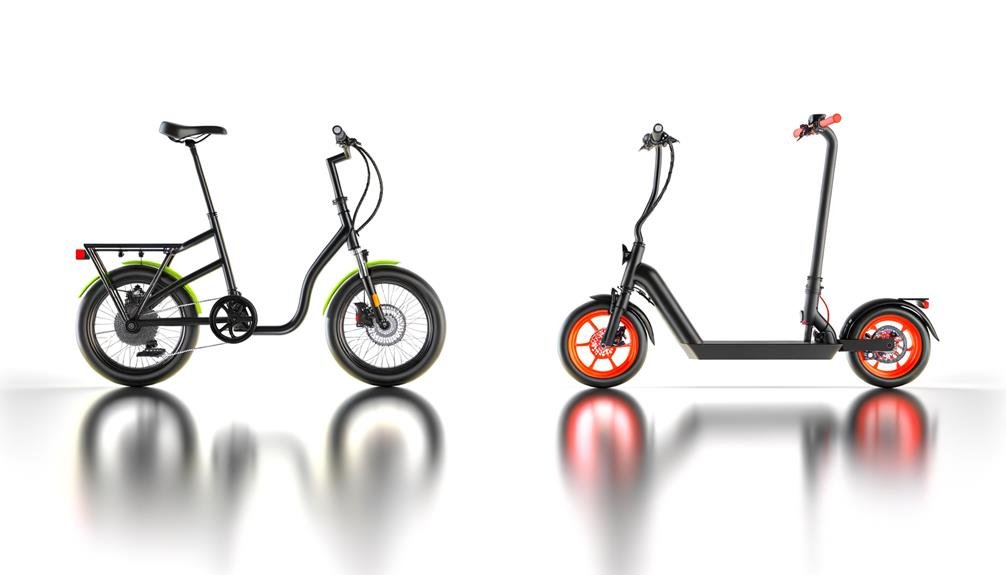Charles Miller is a veteran bike enthusiast with over 12 years of experience dealing with bikes as a mechanic. Despite immense love and expertise for...
In our horse-and-buggy days, who could have predicted the transportation quandaries we're facing today? We've observed a peculiar phenomenon in our modern world: we can legally ride an electric bike, but not an electric scooter.
How did we end up here? It seems counterintuitive, doesn't it? The rules and regulations surrounding these electric-powered modes of transport are not as cut and dried as one might think. There's a tangled web of legislation, safety concerns, and design differences that we need to untangle to fully understand this conundrum.
So, let's roll up our sleeves and start making sense of it, shall we?
- Key Takeaways
- Understanding Electric Bike Regulations
- Legal Restrictions on Electric Scooters
- Safety Measures for Riding E-Bikes
- Risks Associated With Electric Scooters
- The Design Difference: Bikes Vs. Scooters
- Pilot Schemes for Scooter Legalisation
- Insurance Requirements for E-Bikes and Scooters
- Frequently Asked Questions
- Conclusion
Key Takeaways
- Electric bikes are legally compliant with specific regulations and can be ridden on roads and in cycle lanes by individuals aged 14 and over.
- Electric scooters, on the other hand, are classified as motor vehicles and don't meet the same regulations as electric bikes.
- Electric scooters are banned on public roads in many places, except for government-backed trials, and can only be ridden on private land with permission.
- The lack of compliance with regulations for electric scooters poses safety risks and emphasizes the need for comprehensive, inclusive policies and regulations for all types of e-scooters.
Understanding Electric Bike Regulations
When it comes to understanding electric bike regulations, it's crucial to know that E-bikes are legally compliant with specific construction, power output, and speed limits, making them permissible to be ridden on roads and in cycle lanes by individuals aged 14 and over. Their compliance with road traffic laws means that they aren't classed as a motor vehicle, and thus, are exempt from certain restrictions that would apply to cars or motorcycles.
The heart of these regulations lies in the bike's pedal assist feature. This unique characteristic provides power only when pedalling, ensuring the bike doesn't exceed the set speed limit, a significant factor in making electric bikes legal for road traffic.
However, it's worth noting that these regulations can vary based on the country or specific region. It's our responsibility as part of the E-bike community to stay informed about these rules and adhere to them strictly. By doing so, we can enjoy the convenience and environmental benefits of E-bikes, while ensuring we're ridden on public roads safely and legally.
Our understanding of electric bike regulations brings us together, strengthening our sense of belonging in this growing community.
Legal Restrictions on Electric Scooters
Diving into the realm of electric scooters, we find a stark contrast in their legal restrictions compared to E-bikes, predominantly due to their classification as motor vehicles, which consequently means they don't meet the same regulations. This classification results in a unique set of challenges for those wishing to ride an electric scooter.
Legal restrictions on electric scooters are primarily due to safety concerns and their inability to comply with construction and use regulations, such as maximum power output and speed. Riding an electric scooter on public roads without proper compliance can lead to penalties. Furthermore, a rise in serious injuries related to electric scooter use is alarming.
Currently, electric scooters are banned on public roads in many places like New South Wales, due to these safety concerns. Only scooters part of government-backed trials can grace public roads. Privately owned scooters are limited to private land use. Yet, changes may be on the horizon, as governments consider treating electric scooters like E-bikes.
These potential changes may include implementing maximum speed limits, power output limits, and restrictions on where they can be ridden, ensuring the safety of all road users.
Safety Measures for Riding E-Bikes

While the legal landscape surrounding electric scooters continues to evolve, it's essential to shift our focus to the safety measures necessary when riding e-bikes. As we connect with the thrill of pedal power and the freedom an electric bike offers, safety should never be compromised.
To ensure we all enjoy a secure ride, here are some safety measures for riding e-bikes:
- Wear a helmet: It's not just about obeying the law; it's about protecting our heads from serious injuries.
- Follow traffic rules: Use bike lanes and bike paths whenever possible, follow traffic signals, and always ride with the flow of traffic.
- Maintain visibility: Use visible rear red lights and front lights, especially in low light conditions. This helps make us noticeable to other road users.
- Regular maintenance: Regularly inspect the brakes, tires, and overall condition of the bike. A well-maintained e-bike is a safer e-bike.
These steps not only help us stay safe, but they also contribute to a more harmonious co-existence on our roads. Let's embrace these measures as we continue to navigate our way around the evolving landscape of personal electric transport.
Risks Associated With Electric Scooters
As we turn our attention to electric scooters, it's important to consider the associated risks.
Injury statistics indicate a growing concern for rider safety.
Regulatory compliance is a complex, often confusing, aspect of e-scooter usage.
Let's explore the specifics of these issues in detail.
Injury Statistics on E-Scooters
In light of the escalating number of serious injuries associated with electric scooters, there's a growing concern over their safety. As a popular mobility device, they're increasingly seen zipping through city streets, yet many of us may be unaware of the risks involved.
- Injury statistics on e-scooters are alarming, with a significant rise in reported accidents.
- Unlike when you ride an electric bike, e-scooters' compact size and speed can make them less visible, causing accidents.
- Electric scooters, like all two-wheeled vehicles, require balance and quick reflexes, which not everyone possesses.
- City streets often pose unforeseen hazards that can result in serious accidents.
In short, while e-scooters offer a convenient transport solution, they also bring a set of safety challenges that can't be ignored.
Safety Regulations and Compliance
Given these alarming injury statistics, it's crucial we examine the current safety regulations and compliance issues surrounding electric scooters.
Unlike electric bikes, scooters don't comply with construction and use regulations, making them illegal to ride on public roads. This lack of compliance can lead to penalties, adding to the risks.
A rise in severe injuries emphasises these safety concerns. Currently, you're only allowed to ride your scooter on private land, with the owner's permission. However, change could be on the horizon.
The government is mulling over treating electric scooters like electric bikes, exploring regulations including speed limit and power output limits. The electric motor's capabilities are under scrutiny, as safety remains paramount.
The Design Difference: Bikes Vs. Scooters

While e-bikes and e-scooters may appear similar at first glance, a deeper look at their design and regulations reveals some stark differences that significantly impact their legality and usage.
When examining bikes vs. scooters, the design difference is contextually relevant and provides insight into why we can ride an electric bike, but not a scooter.
- Electric bikes conform to strict construction and use regulations, making them legal and safe for use. They've a maximum power output of 250 watts and can reach speeds of up to 15.5 mph.
- E-scooters, on the other hand, fail to meet these regulations. Classed as motor vehicles, they face penalties for non-compliance when ridden on public roads.
- E-bikes are exempt from certain road traffic acts, including requirements for insurance, helmets, tax, and registration, making them more accessible to the general public.
- Scooters lack these exemptions, making their use more restricted. Privately owned e-scooters can't be ridden on public roads and may lack necessary features for safe road use.
These design differences substantially affect the legality and possibilities for riding these two types of vehicles.
Pilot Schemes for Scooter Legalisation
As we turn our focus to the pilot schemes for scooter legalisation, we must scrutinise the potential legal challenges and the proposed solutions.
We'll analyse how these schemes, if implemented, could impact urban mobility.
It's also crucial to contemplate the government's consultative approach to garner public feedback on these regulations.
Evaluating Scooter Pilot Schemes
In evaluating scooter pilot schemes, there are several key aspects to consider. One important factor is the legal framework and regulations that apply to electric scooters. This includes examining the laws surrounding their use and any specific requirements for safety equipment or licensing. Additionally, it is crucial to assess the potential safety implications of electric scooters and how they may impact public reception.
Government monitoring of safety outcomes and public perception is another critical consideration. This involves evaluating the effectiveness of safety measures implemented in pilot schemes and gauging public attitudes towards electric scooters. Understanding how the public perceives these vehicles can help inform future regulations and policies.
The role of local authorities in assessing the impact of private rental schemes is also significant. Local governments play a crucial role in monitoring and regulating scooter usage within their jurisdictions. By evaluating the impact of these rental schemes, authorities can better understand their benefits and drawbacks and make informed decisions about their implementation.
Another important aspect to evaluate is the possible alignment of scooter regulations with those for Personal Light Electric Vehicles (PLEVs). PLEVs include a range of electric-powered devices such as e-bikes and Segways. Assessing whether scooter regulations can be harmonized with existing PLEV rules can help create a cohesive framework for electric mobility devices.
Lastly, public acceptance of scooters on the road is a crucial factor for successful integration into transport systems. Understanding the public's acceptance and willingness to share the road with electric scooters is essential for their safe and widespread use.
Legal Challenges and Solutions
Navigating the legal landscape of e-scooter legalization presents several challenges and opportunities. Potential regulations, including speed limits and power output limits, are under consideration and could be similar to those for e-bikes. The current pilot scheme for e-scooters is shaping the future of this Personal Light Electric Vehicle. However, legal challenges and solutions aren't straightforward.
The current scheme allows us to ride rented scooters on roads and cycle lanes, which are rights reserved for motor vehicles. In contrast, private e-scooters are confined to private lands. This clear disparity exists between these two categories. To foster a sense of belonging and fairness, we need to address this dichotomy and work towards a comprehensive, inclusive policy.
A comprehensive policy would cover both rented and privately-owned scooters, similar to the regulations for electric bikes. This approach would provide a consistent framework for all users, ensuring equal treatment and a level playing field for both types of e-scooters.
Impact on Urban Mobility
Having wrestled with the legal hurdles, it's imperative now to gauge how electric scooter legalization through pilot schemes can revolutionize urban mobility. The potential impact is immense.
Riding electric scooters can enhance electric mobility by providing an eco-friendly transport option. They can also alleviate traffic congestion, given their compact size. Furthermore, they can promote a shift from car-centric to more sustainable modes of transport. Additionally, electric scooters can foster social inclusion by offering an affordable and accessible transport option.
However, it's crucial to ensure the safety of scooter riders and pedestrians alike. As we continue to navigate the intersection between the bike and scooter world, we must keep the conversation going, seeking solutions that harmonize the benefits of both for greater urban mobility.
Insurance Requirements for E-Bikes and Scooters
When comparing e-bikes and electric scooters, it's crucial to understand the differing insurance requirements due to their distinct legal classifications.
Electric Bicycles, or e-bikes, enjoy a more relaxed legal status. Being categorized as power-assisted pedal bicycles, they're exempt from road traffic acts that require insurance, helmets, tax, and registration. This means privately owned e-bikes can freely glide our public roads without the need for insurance.
In stark contrast, electric scooters, despite their resemblance to the Personal Light Electric Vehicle category, face stricter regulations. Currently, they're classified as motor vehicles, which require insurance, license, and registration if used under an approved rental scheme. However, privately owned scooters are prohibited on public roads, their use being limited to private land.
The potential for a future where e-scooters are legally allowed on public roads is being considered by the government. Yet, even then, the insurance requirements for e-bikes and scooters would likely remain distinct, with scooters needing insurance and adhering to power output limits.
Frequently Asked Questions
Why Are Electric Scooters Not Allowed?
We're prohibited from riding electric scooters due to strict scooter regulations, legal implications, and concerns for pedestrian safety. Also, current infrastructure requirements and urban congestion issues limit their use despite their positive environmental impact.
What Is the Difference Between E-Bike and Scooter?
We're comparing apples and oranges here. E-bike advantages lie in their bike-like mechanics and regulations, making them road-legal. Scooter limitations stem from their design and usage, which doesn't fit current road laws.
Which Is Safer Electric Scooter or Electric Bike?
We're analyzing safety between e-bikes and e-scooters. Considering safety gear necessity, scooter accidents statistics, bike riding precautions, e-scooter maneuverability, bike stability, and scooter's terrain versatility, it's a complex issue with no clear winner.
What Is Faster Electric Scooter or Bike?
We've found that bike acceleration times often outpace scooter speed limits. However, terrain adaptability and traffic impact can affect this. Despite scooters' comparative efficiency, maintenance costs may tilt the balance in favor of bikes.
Conclusion
As we navigate the winding road of e-mobility, it's clear that while electric bikes have found their legal lane, scooters are still waiting at the red light.
The safety concerns and design differences are significant speed bumps, but with careful regulation, they could soon join the e-bike in the fast lane.
It's a journey that requires caution and awareness, but the destination – a greener, more efficient transport society – is surely worth the ride.

Charles Miller is a veteran bike enthusiast with over 12 years of experience dealing with bikes as a mechanic. Despite immense love and expertise for his Tacoma, he rides his Trek Ebike more. Anytime you meet him, you’ll either hear him talking about Bikes, or writing about all things bikes and cars on this blog.
More Posts


